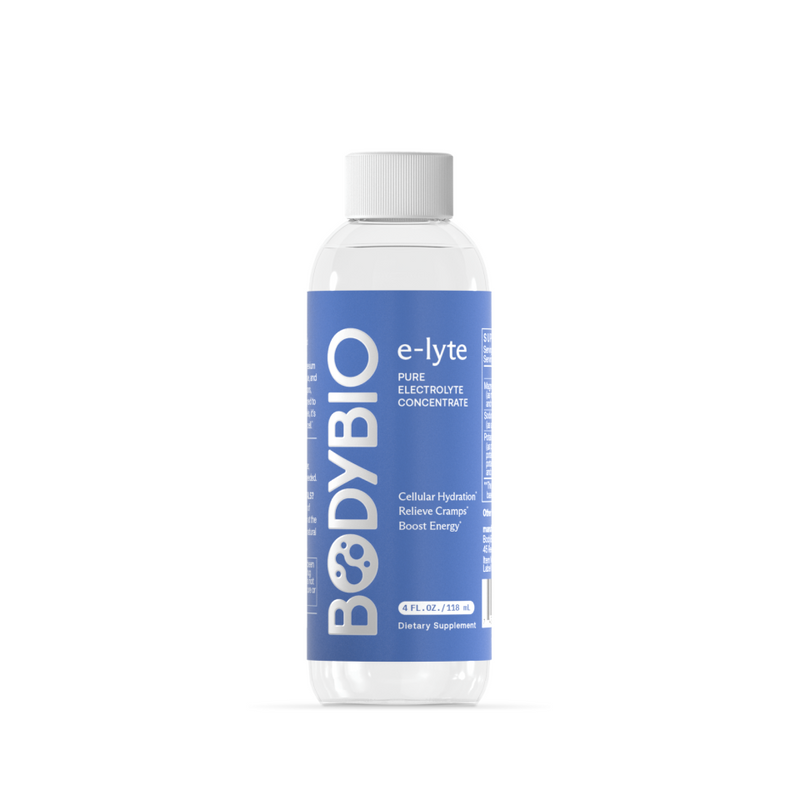How to Fix pH Balance: Assessing Alkaline & Acidity Levels in the Gut
Authors:

Dr. Thomas Wnorowski
PhD, CNCC Research Director, BodyBio & Biomedical Nutritionist
Key Takeaways:
Key Points:
- Proper pH levels are extremely important in the digestive process. They play a role throughout the entire gut — helping us to break down food, draw in nutrients, and eliminate waste.
- When pH levels are imbalanced in the stomach, this can cause numerous different symptoms, including acid reflux, stomach pains, and indigestion.
- There are several natural remedies to help ease acid reflux and indigestion, but the best ones are nutrients that help us create and use stomach acid, like magnesium and potassium.
You thought pH testing was reserved for high school biology class.
Or maybe for the classmates who pursued a science major in college.
But did you know your digestion is guided by careful pH balances in the stomach, small intestine, and large intestine?
Yep. If the acidic or alkaline environment in your gut is imbalanced, it can cause a variety of symptoms — like nausea, heartburn, and diarrhea.
This makes healing tricky — because most of us don’t assume abnormal pH levels are linked to gut dysbiosis (or poor microbiome health). Often, this is the last thing we think about when uncovering the root of our symptoms. But it shouldn’t be.
Let’s explore how to fix pH balance as well as learn the key signs and symptoms of an unbalanced pH in the body.
Table of Contents:
- Exploring pH Levels Through the Digestive System
- Understanding Stomach Acid pH
- Symptoms of Unbalanced pH Levels
- Should You Test Your pH Levels?
- How to Fix pH Balance
- The Building Blocks to Better pH Levels in the Gut
Exploring pH Levels Through the Digestive System
The digestive system relies on multiple different pH levels to digest food and absorb nutrients. It starts with our saliva — which is more alkaline, then leads to a highly acidic environment in our stomachs, and ends again at alkaline, allowing our bodies to absorb nutrients well.
On a scale of 1-14, a pH level of 7 is considered neutral. Higher numbers signify an alkaline or base environment, and lower numbers indicate acidity.
| Location | Typical pH Range | Environment | Digestive Role |
|---|---|---|---|
| Saliva (Mouth) | 6.5 – 7.5 | More alkaline | Gentle enough to protect teeth and gums; allows stomach acid to lead digestion |
| Stomach | 1 – 2 | Extremely acidic | Breaks down food particles; kills bacteria and pathogens |
| Small Intestine | Near neutral | Gradually becomes alkaline | Extracts nutrients from food |
| Large Intestine | Starts around 6, ends near 7 | Slightly acidic to neutral | Final stage of digestion as waste exits the colon |
Saliva pH Level
Your saliva should be more alkaline, with a normal pH level of 6.5 to 7.5. It’s gentle enough to prevent discomfort and protect our teeth and gums. Alkaline saliva leaves the stomach acid to do the heavy lifting in the digestion process.
Stomach pH Level
The stomach uses an extremely acidic environment (around 1 to 2) to break down large food particles into much smaller food particles, so the small intestine can then do its job of extracting vital nutrients. Stomach acid also helps to kill unhealthy bacteria and other pathogens, guarding our bodies from infection.
Small Intestine pH Level
In the small intestine, pH levels gradually become more alkaline, almost reaching neutral in the lower part of the small intestine. This environment allows our bodies to extract vital nutrients from food.
Large Intestine pH Level
Once again, pH levels change in the large intestine. Upon entrance, the pH level drops to around 6 but gradually works toward 7 (neutral) as waste exits the colon.
Understanding Stomach Acid pH
Potential of Hydrogen (or pH) is a measurement of the alkaline and acid levels in our gut, bloodstream, and different areas of the body.
When it comes to digestion, pH is particularly important in the stomach.
Our stomachs use extremely acidic environments to break down food and jumpstart digestion. Too much gastric acid can turn into heartburn, while too little stomach acid may lead to bloating, cramping, acid reflux, and poor digestion. Further below, we’ve included a master list of symptoms so you can compare and contrast with your own experience.
Here are the classifications for stomach acid pH imbalance:
- Hyperchlorhydria — Too much acid production in the stomach.
- Hypochlorhydria — Too little acid production in the stomach.
- Achlorhydria (very rare) — No acid production at all.
Symptoms of Unbalanced pH Levels
Poor microbiome health isn’t uncommon — and those who struggle with it may look to more popular root causes, like bad bacteria (gut dysbiosis), leaky gut, or even nervous system imbalance, for answers.
Don’t underestimate gut pH levels, though. The human body is very careful about maintaining the ideal alkaline-to-acid levels. If this is thrown off, all sorts of issues could ensue.
Since symptoms of unbalanced pH levels may vary based on whether you have too much stomach acid or too little, we’ve created a few different categories.
Symptoms of Too Much Stomach Acid (Hyperchlorhydria)
- Heartburn
- Bloating
- Nausea
- Diarrhea
- Weight loss
- Loss of appetite
- Stomach ulcers
Symptoms of Too Little Stomach Acid (Hypochlorhydria)
- Bloating
- Cramping
- Undigested food in the stool
- Malabsorption and malnourishment
- Indigestion
- GERD or acid reflux
Symptoms of No Acid Production in the Gut (Achlorhydria)
- A burning sensation after eating
- Heartburn
- Weight loss
- Malabsorption and malnourishment
- Bloating
- Cramping
- Diarrhea
- Decreased appetite
Should You Test Your pH Levels?
Should you have a concern about your pH levels in your digestive tract, you likely want to know about your stomach pH (to indicate high or low stomach acid production). You can actually get your stomach acid tested through your functional medicine doctor. However, this test is invasive and is typically ordered if no other options are available.
Some at-home tests may help if you’re not quite ready for invasive testing. One test uses baking soda to potentially uncover low stomach acid. On an empty stomach, mix half a glass of cold water with 1/4th teaspoon of baking soda. The goal is for the baking soda and your stomach acid to mix — producing carbon dioxide and forcing you to burp. If you don’t burp within 3-5 minutes of consumption, then you may have low stomach acid. The validity of this test is debated, but it’s worth trying if you already have some symptoms of low stomach acid.
While a typical stool test can’t test for stomach acid, you may be able to deduce low stomach acid from your results. For instance, rampant food sensitivities, bacterial overgrowth, parasites, and yeast infections could indicate you don’t have enough stomach acid to kill off these infections when they enter the digestive tract.
If you suspect high or low stomach acid, we recommend working with your practitioner to evaluate symptoms first. Symptoms can tell you a lot about the type of imbalance you may have — and often, practitioners can help you overcome high or low stomach acid without always requiring an invasive test.
How to Fix pH Balance
There are several natural ways to fix your pH balance. Here are some of our favorites.
| Strategy | How It Helps | Key Notes |
|---|---|---|
| Alkaline Diet | Neutral foods can calm digestion for those with high stomach acid | Not sustainable long-term; excludes key food groups like meat and dairy |
| Alkaline Water | May help with acid reflux or GERD symptoms | Use with caution in low-acid environments; monitor symptoms and consult a provider |
| Fewer Acidic & Processed Foods | Reduces triggers for acid reflux and eases digestion | Processed foods can disrupt natural pH balance due to synthetic ingredients |
| Magnesium | Supports stomach acid production and reduces esophageal spasms | Combine with potassium and other stomach acid–supportive nutrients |
| Check Your Medication | Some medications reduce stomach acid and increase heartburn symptoms | Review side effects and talk to your healthcare provider about alternatives |
| Apple Cider Vinegar | May enhance stomach acidity and digestion for those with low stomach acid | Take 1–2 tsp in water before meals; also supports post-meal blood sugar balance |
Alkaline Diet
Neutral or alkaline foods are safer options for those with excess stomach acid. Leafy vegetables, bananas, apples, beets, and pumpkin seeds are all fantastic options to calm the digestive process. However, an alkaline diet is difficult to maintain and removes a lot of important food groups, like meat and dairy. We don’t recommend staying on it long-term.
Alkaline Water
Regular water is neutral on the pH scale. However, alkaline water can help fight against acid reflux and GERD related to high stomach acid. It’s also praised for other benefits, like better hydration and improved digestion. Of course, everyone’s different. Although alkaline water has been known to help with acid reflux (due to both low and high stomach acid), it should be used with caution. You don’t want to further alkalize a low stomach acid environment. If you use it, make sure to check in on your symptoms regularly and consult with your healthcare provider.
Fewer Acidic and Processed Foods
Acidic foods like tomatoes and chocolate may set off acid reflux. At the same time, processed foods can interfere with our body’s careful pH balance. Since many processed foods contain synthetic or incomplete ingredients, they are difficult to digest and require more time (and resources) for digestion.
Magnesium
This essential mineral is needed for stomach acid synthesis. So, if you have low stomach acid, we recommend supplementing with magnesium and other minerals (like potassium) and nutrients that help create stomach acid. Magnesium can also help reduce spasms in the esophagus — meaning it can protect against acid reflux symptoms.
Check Your Medication
Have you checked the side-effects list on the back of your medication lately? Many pharmaceutical medications (including over-the-counter drugs) lead to changes in stomach acid levels, making heartburn more prevalent. You may want to look into finding something else that works for you, without the side effects.
Drink Apple Cider Vinegar Before Meals
Since raw apple cider vinegar is acidic, it can contribute to the naturally acidic environment of the stomach. If you struggle with low stomach acid, drinking a teaspoon or two of apple cider vinegar in water before a meal can help improve digestion.
Bonus: Drinking apple cider vinegar before meals also improves blood sugar balance post-meal!
The Building Blocks to Better pH Levels in the Gut
There are tons of resources out there that show you how to address the symptoms of a pH imbalance in the gut. But few actually focus on giving the gut the nutrients and fundamental building blocks it needs to create healthy stomach acid levels.
Electrolytes are one essential resource that does this. Magnesium and potassium, specifically, are used by the body to create stomach acid.
Not only does electrolyte intake help bring your body’s pH levels back to homeostasis, but it can also provide much-needed hydration and cellular support for those with long-term digestive issues and malnourishment.
Fallingborg J. (1999). Intraluminal pH of the human gastrointestinal tract. Danish medical bulletin, 46(3), 183–196.
Fatima, R., & Aziz, M. (2023, August 14). Achlorhydria. In StatPearls [Internet]. Treasure Island (FL): StatPearls Publishing. Retrieved January 2024, from https://www.ncbi.nlm.nih.gov/books/NBK507793/
Geibel J. P. (2005). Role of potassium in acid secretion. World journal of gastroenterology, 11(34), 5259–5265. https://doi.org/10.3748/wjg.v11.i34.5259
Hadi A, et al. (2021). The effect of apple cider vinegar on lipid profiles and glycemic parameters: a systematic review and meta-analysis of randomized clinical trials. BMC Complement Med Ther., 21(1):179. https://doi.org/10.1186/s12906-021-03351-w
Puscas I, Nadaban F, Voicu L, et al. (1977). Magnesium and gastric acid secretion. Acta Hepatogastroenterol (Stuttg), 24(4):288-292.
Yamamura, R., Inoue, K. Y., Nishino, K., & Yamasaki, S. (2023). Intestinal and fecal pH in human health. Frontiers in Microbiomes, 2(2023). https://doi.org/10.3389/frmbi.2023.1192316



